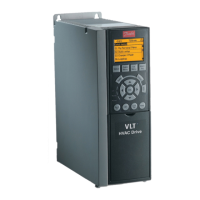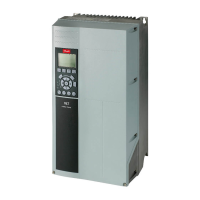VLT
®
FCM Series
1. The load drives the motor (at constant output
frequency from the frequency converter), i.e.
the load generates energy.
2. During deceleration ("ramp-down") if the moment of
inertia is high, the load is low and the ramp-down
time is too short for the energy to be dissipated
as a loss in the VLT frequency converter, the
motor and the installation.
The control unit attempts to correct the ramp if possible.
The inverter turns off to protect the transistors
and the intermediate circuit capacitors when a
certain voltage level is reached.
M
ains drop-out
During a mains drop-out, FCM 300 Series continues
until the intermediate circuit voltage drops below the
minimum stop level, which is typically 15% below
FCM 300 Series’s lowest rated supply voltage.
The time before the inverter stops depends on the mains
voltage before the drop-out and on the motor load.
S
tatic overload
When FCM 300 Series is overloaded (the current
limit in parameter 221 has been reached), the
controls will reduce the output frequency in an
attempt to reduce the load.
If the overload is excessive, a current may occur that
makes the FC motor cut out after approx. 1.5 sec.
■ Acoustic noise
Below are the typical values measured at a distance
of 1 m from the unit at full load:
2pole 4pole
FCM 305 54 dB(A)
FCM 311 58 dB(A)
FCM 315 59 dB(A)
FCM 322 58 dB(A)
FCM 330 61 dB(A)
FCM 340 62 dB(A) 63 dB(A)
FCM 355 64 dB(A) 60 dB(A)
FCM 375 61 dB(A)
■ Balance
The FCM 300 is balanced to class R according to
ISO8821 (re
duced balance). For critical applications
especially at high speed (>4000 RPM) special
balance (class S) might be required.
MG.03.H3.02 - VLT is a registered Danfoss trademark
88
